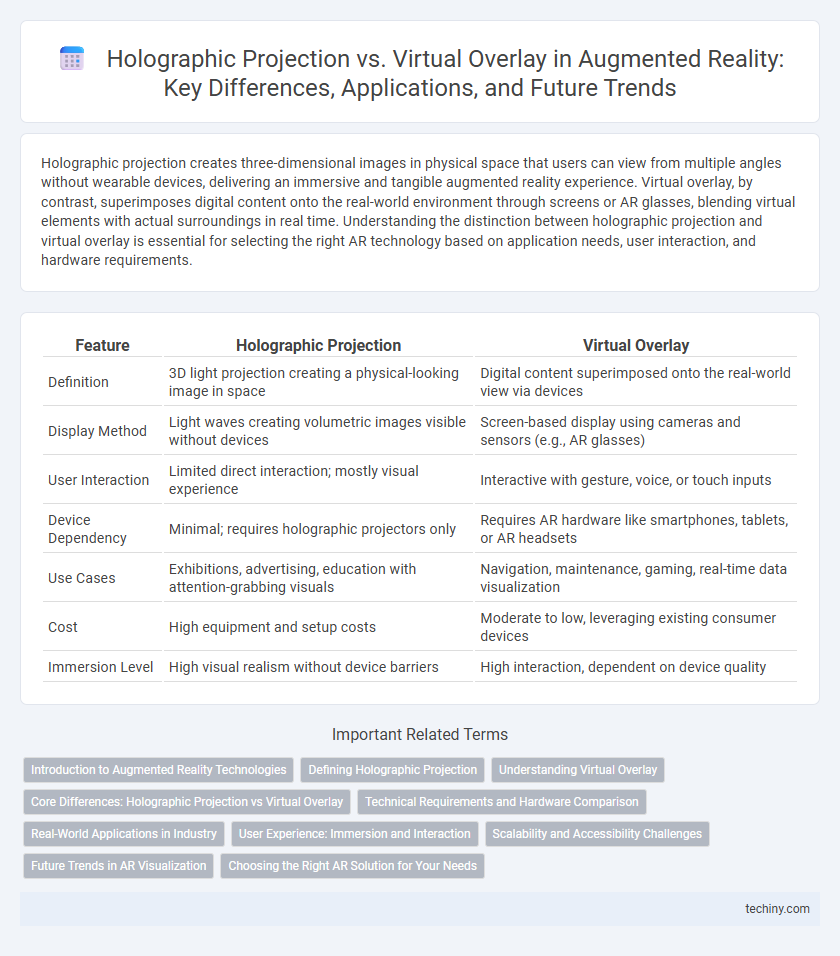Holographic projection creates three-dimensional images in physical space that users can view from multiple angles without wearable devices, delivering an immersive and tangible augmented reality experience. Virtual overlay, by contrast, superimposes digital content onto the real-world environment through screens or AR glasses, blending virtual elements with actual surroundings in real time. Understanding the distinction between holographic projection and virtual overlay is essential for selecting the right AR technology based on application needs, user interaction, and hardware requirements.
Table of Comparison
| Feature | Holographic Projection | Virtual Overlay |
|---|---|---|
| Definition | 3D light projection creating a physical-looking image in space | Digital content superimposed onto the real-world view via devices |
| Display Method | Light waves creating volumetric images visible without devices | Screen-based display using cameras and sensors (e.g., AR glasses) |
| User Interaction | Limited direct interaction; mostly visual experience | Interactive with gesture, voice, or touch inputs |
| Device Dependency | Minimal; requires holographic projectors only | Requires AR hardware like smartphones, tablets, or AR headsets |
| Use Cases | Exhibitions, advertising, education with attention-grabbing visuals | Navigation, maintenance, gaming, real-time data visualization |
| Cost | High equipment and setup costs | Moderate to low, leveraging existing consumer devices |
| Immersion Level | High visual realism without device barriers | High interaction, dependent on device quality |
Introduction to Augmented Reality Technologies
Holographic projection creates three-dimensional images that appear to occupy real space, allowing users to view and interact with digital content without wearing devices. Virtual overlay technology superimposes computer-generated graphics onto a live view of the physical world, typically through headsets or smartphone screens. Both technologies enhance user experience in augmented reality by blending digital elements with the real environment, but holographic projection offers a more immersive spatial presence compared to the screen-bound virtual overlay.
Defining Holographic Projection
Holographic projection is a cutting-edge technology that creates three-dimensional images by manipulating light to project fully volumetric visuals into physical space without the need for special glasses. Unlike virtual overlays, which superimpose digital information onto the real world through transparent displays or devices, holographic projections offer true spatial depth and parallax, enhancing immersive experiences. This technology is pivotal in augmented reality applications where realistic and interactive 3D models significantly improve user engagement and spatial understanding.
Understanding Virtual Overlay
Virtual overlay in augmented reality superimposes digital information directly onto the real-world environment, enhancing user interaction by blending virtual elements with physical surroundings. Unlike holographic projection, which creates three-dimensional images visible from multiple angles without a device, virtual overlays require screens or wearable devices to display content aligned with real objects. This technology supports applications in navigation, maintenance, and training by providing real-time, context-sensitive data seamlessly integrated into the user's view.
Core Differences: Holographic Projection vs Virtual Overlay
Holographic projection creates three-dimensional images that exist independently in physical space, enabling users to view objects from multiple angles without wearables. Virtual overlay, conversely, superimposes computer-generated graphics onto a user's real-world view through devices like AR glasses or smartphones, integrating digital content with the physical environment. The core difference lies in holographic projection's free-standing 3D visualization, whereas virtual overlay relies on augmenting a live camera feed or direct line-of-sight display.
Technical Requirements and Hardware Comparison
Holographic projection requires advanced spatial light modulators, high-resolution projectors, and specialized environments to render three-dimensional images visible without glasses, demanding significant processing power and precise calibration. Virtual overlay relies on lightweight AR headsets or smartphones equipped with cameras, sensors, and AR software to superimpose digital content onto real-world views, prioritizing portability and real-time tracking. Both technologies necessitate robust GPU capabilities and sensor fusion, but holographic projection typically incurs higher costs and infrastructure complexity compared to the more accessible virtual overlay systems.
Real-World Applications in Industry
Holographic projection enables the visualization of 3D images in open space without the need for headsets, enhancing collaborative design and training in manufacturing and healthcare industries. Virtual overlays, deployed through AR glasses or mobile devices, superimpose digital information onto physical objects, improving real-time maintenance, assembly, and quality inspections in automotive and aerospace sectors. Both technologies drive increased efficiency and accuracy by integrating digital insights directly into industrial workflows.
User Experience: Immersion and Interaction
Holographic projection offers a more immersive user experience by presenting true 3D images that occupy real space, allowing natural interaction without headsets or screens. Virtual overlay enhances interaction by superimposing digital content onto the physical environment via AR devices, maintaining seamless context but often restricting freedom of movement. User engagement is heightened in holographic projection through spatial presence, whereas virtual overlay excels in practical applications with precise contextual information.
Scalability and Accessibility Challenges
Holographic projection faces significant scalability challenges due to the high cost of advanced hardware and spatial requirements, limiting widespread adoption. Virtual overlay technology offers greater accessibility through compatibility with existing smartphones and AR glasses, enabling broader user reach. However, virtual overlays can suffer from environmental dependency, affecting consistent performance across diverse settings.
Future Trends in AR Visualization
Holographic projection is evolving to create fully lifelike 3D images in physical space, while virtual overlay enhances real-world environments with interactive digital information. Future trends in AR visualization emphasize seamless integration of holograms and overlays via advanced AI-driven rendering and 5G connectivity, enabling ultra-realistic, context-aware experiences. Emerging technologies like light-field displays and spatial computing will further blur the line between virtual and physical realities, driving widespread adoption in education, healthcare, and retail sectors.
Choosing the Right AR Solution for Your Needs
Holographic projection offers immersive 3D visuals that integrate seamlessly into physical environments, ideal for presentations and interactive displays. Virtual overlay enhances real-world views by superimposing digital information onto existing surfaces, providing practical applications for navigation and maintenance tasks. Selecting the right augmented reality solution depends on the level of interactivity required, environmental integration, and specific user objectives.
Holographic Projection vs Virtual Overlay Infographic

 techiny.com
techiny.com